Method for quantitatively determining cholesterol in high density lipoprotein and reagents therefor
a high density lipoprotein and quantitative method technology, applied in biochemistry apparatus and processes, instruments, thiazine dyes, etc., can solve the problems of long operation time, complicated fractionation step, safety problems, etc., and achieve the effect of simple and accura
- Summary
- Abstract
- Description
- Claims
- Application Information
AI Technical Summary
Benefits of technology
Problems solved by technology
Method used
Image
Examples
example 1
Kit for Quantitatively Determining HDL Cholesterol
[0265]A kit for quantitatively determining HDL cholesterol comprising the following first reagent and second reagent was prepared.
[0266]
HEPES (pH 7.5)10mmol / LEMSE0.3g / LSodium dextran sulfate1.0g / L(molecular weight: 500,000)BSA2.0g / LNymeen L2070.07g / L
Second Reagent (Reagent a)
[0267]
HEPES (pH 7.0)10mmol / L4-Aminoantipyrine0.3g / LPeroxidase20kU / LLPL60.05kU / LCOO3213.0kU / L
example 2
Kit for Quantitatively Determining HDL Cholesterol
[0268]A kit for quantitatively determining HDL cholesterol comprising the following first reagent and second reagent was prepared.
First Reagent (Reagent A)
[0269]
HEPES (pH 7.5)10mmol / LEMSE0.3g / LSodium dextran sulfate1.0g / L(molecular weight: 500,000)BSA2.0g / LNymeen L2070.07g / L
Second Reagent (Reagent b)
[0270]
HEPES (pH 7.0)10mmol / L4-Aminoantipyrine0.3g / LPeroxidase20kU / LChemically modified LPL3110.2kU / LCOO3213.0kU / L
example 3
Kit for Quantitatively Determining HDL Cholesterol
[0271]A kit for quantitatively determining HDL cholesterol comprising the following first reagent and second reagent was prepared.
First Reagent (Reagent A)
[0272]
HEPES (pH 7.5)10mmol / LEMSE0.3g / LSodium dextran sulfate1.0g / L(molecular weight: 500,000)BSA2.0g / LNymeen L2070.07g / L
Second Reagent (Reagent c)
[0273]
HEPES (pH 7.0)10mmol / L4-Aminoantipyrine0.3g / LSodium cholate6.0g / LPeroxidase20kU / LLPL60.05kU / LCOO3213.0kU / L
PUM
| Property | Measurement | Unit |
|---|---|---|
| pH | aaaaa | aaaaa |
| concentration | aaaaa | aaaaa |
| concentration | aaaaa | aaaaa |
Abstract
Description
Claims
Application Information
 Login to View More
Login to View More - R&D
- Intellectual Property
- Life Sciences
- Materials
- Tech Scout
- Unparalleled Data Quality
- Higher Quality Content
- 60% Fewer Hallucinations
Browse by: Latest US Patents, China's latest patents, Technical Efficacy Thesaurus, Application Domain, Technology Topic, Popular Technical Reports.
© 2025 PatSnap. All rights reserved.Legal|Privacy policy|Modern Slavery Act Transparency Statement|Sitemap|About US| Contact US: help@patsnap.com


